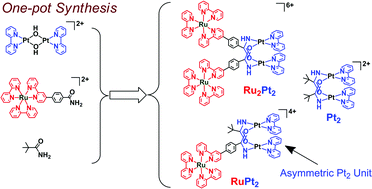Amidate-bridged diplatinum(II) entities [Pt2(bpy)2(μ-amidato)2]2+ (amidate = pivalamidate and/or benzamidate; bpy = 2,2′-bipyridine) were covalently linked to one or two Ru(bpy)32+-type derivatives. An amide group was introduced at the periphery of Ru(bpy)32+ derivatives to give metalloamide precursors [Ru(bpy)2(BnH)]2+ (abbreviated as RuBnH, n = 1 and 2), where deprotonation of amideBnH affords the corresponding amidate Bn, B1H = 4-(4-carbamoylphenyl)-2,2′-bipyridine, and B2H = ethyl 4′-[N-(4-carbamoylphenyl)carbamoyl]-2,2′-bipyridine-4-carboxylate. From a 1 : 1 : 1 reaction of [Pt2(bpy)2(μ-OH)2](NO3)2, RuBnH, and pivalamide, trinuclear complexes [Pt2(bpy)2(μ-RuBn)(μ-pivalamidato)]4+ (abbreviated as RuBn-Pt2) were isolated and characterized. Tetranuclear complexes [Pt2(bpy)2(μ-RuBn)2]6+ (abbreviated as (RuBn)2-Pt2) were separately prepared and characterized in detail. The quenching of the triplet excited state of the Ru(bpy)32+ derivative (i.e., Ru*(bpy)32+) upon tethering the Pt2(bpy)2(μ-amidato)22+ moiety is strongly enhanced in RuB1-Pt2 and (RuB1)2-Pt2, while it is only slightly enhanced in RuB2-Pt2 and (RuB2)2-Pt2. These are partly explained by the driving forces for the electron transfer from the Ru*(bpy)32+ moiety to the Pt2(bpy)2(μ-amidato)22+ moiety (ΔG°ET); the ΔG°ET values for RuB1-Pt2, (RuB1)2-Pt2, RuB2-Pt2, and (RuB2)2-Pt2 are estimated as −0.01, 0.00, +0.22, and +0.28 eV, respectively. The considerable difference in the photochemical properties of the B1- and B2-bridged systems were further examined based on the emission decay and transient absorption measurements, which gave results consistent with the above conclusions.


 Please wait while we load your content...
Please wait while we load your content...